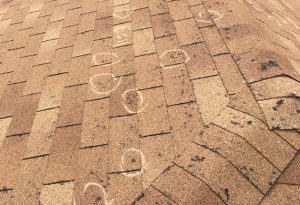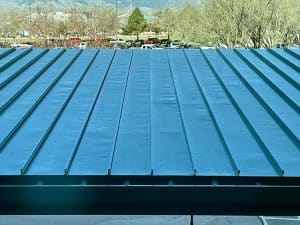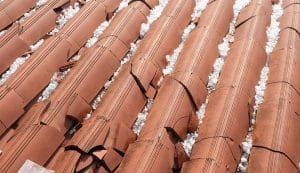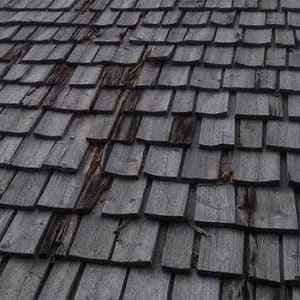Roof hail damage can be costly and extensive. Here in Colorado, we often don’t know how large hailstones will be and get little notice of a storm. Below, you’ll see when we get most of our hail storms, what hail damage on a roof looks like, and what your hail resistant roofing options are, for both commercial and residential buildings.
Quick Answer: What does roof hail damage in Colorado look like? On asphalt shingles, black dots. On standing seam, cracks or dents. On clay tiles, cracks or shattered tiles. On wood shake, split or shattered wood.
When Does Colorado Get Hail Storms
Coloradoans can expect hail between April and July. However, Colorado’s hail storms typically peak in May and June. According to NOAA National Severe Storms Laboratory, Colorado, Nebraska, and Wyoming usually get the most hailstorms in the U.S. This area, commonly called ‘Hail Alley’, get between 7 to 9 hail days per year. According to The Denver Post, Colorado is ranked second among all states in the number of hail damage claims filed during 2018 and 2020.
Hail storms are serious and can cause a lot of damage, and injury. In Colorado, hailstones vary from pea size to softball size. In July of 2022, 2.5″ size hail was reported in Fort Collins. Hailstones of this size can seriously hurt someone and cause major damage to roofs and other property.
What Roof Hail Damage Looks Like
Asphalt Shingles
Hail damage to asphalt shingles is sometimes obvious. If the hailstones are large enough, or they strike with enough velocity, they can leave your asphalt shingle roof with exposed asphalt. These black spots are often easily seen from the ground. Granules on asphalt shingles are the first line of defense. They protect your shingle roof from UV radiation, rain, hail, etc. Beneath the granules is the asphalt. This is there to adhere the granules to the fiberglass foundation, and help protect your roof deck from moisture. Without the granules, the asphalt can dry quicker as it’s exposed to the sun and heat. This can lead to cracking.
Smaller or less dense stones can still damage your roof even though you can’t see it, especially from the ground. That’s why it’s important to have your roof inspected from a trained roofing professional after a hail storm has passed through your neighborhood. We offer free no-obligation inspections.
If you have an asphalt shingle roof, look for black spots. If you see black spots, look for cracks within them. Black spots mean you have some sort of roofing damage, probably from hail. Cracks within those mean you have a potential water leak in your shingles. These are signs you need a new roof.

Metal Roofing
Metal roofing, such as stone-coated metal shingles and standing seam, are more durable than traditional asphalt shingles, and, as a result, take more of a beating. However, they are not hail proof. They can still crack if struck from large enough hailstones. If you have standing seam metal roofing, looks for dents and cracks, not only on the panels themselves, but also on flashing. Although dents are often purely aesthetic, there may be cracks within or around them. If a hail storm as recently come through your neighborhood, contact us for a free inspection.

Corrugated metal is the most resistant roofing product to hail. It takes a much larger hailstone to damage this type of roofing. The peaks and valleys of corrugated metal are a particularly strong area. When a hailstone strikes here, the stones will either shatter or bounce off. When a hailstone strikes in between these areas, they are simply deflected away. However, as with standing seam, corrugated metal roofing panels are not invincible. It just takes a much larger hail stone to damage them. How large a hail stone? That depends. A small hail stone striking a corrugated metal roof with enough velocity can still cause damage. A large hail stone that’s less dense might not cause any damage at all. Again, if your roof has been exposed to hail, it’s always a good idea to have it inspected, especially since roof inspections are free 🙂
Tiles
Clay, concrete, and slate tiles can crack when hit with enough force. Small cracks aren’t always obvious from the ground. Shattered tiles, on the other hand, often are. Curved tiles, such as Spanish Mission tiles, offer the most hail resistance compared to flat. However, they are not hail proof. Clay tiles are often thinner than concrete tiles. You won’t find dents in clay, concrete or slate tiles. Hail damage to these roofing products are always cracked. So, if a hail storm has come through your neighborhood, have your roof inspected for hail damage.

Wood Shake
Wood shake is the least hail resistant roofing product. Hail damage to wood shake often looks like split shakes. This is especially true for older shake. Large enough hail stones can completely shatter and/or dislodge shake. Smaller hail stones often bounce right off of shake. If your wood shake roof has been exposed to hail, small or large, have it inspected right away.

Regardless of which roofing product you have, if your roof has been exposed to hail, have it inspected immediately. The sooner hail damage is found and dealt with, the less the repairs will cost you.
Your Hail Resistant Roofing Options
‘Hail resistant’ should not be mistaken for ‘hail proof’. There are many hail resistant roofing options available, today. Impact resistant asphalt shingles are the most common. Metal roofing, such as standing seam and corrugated metal are increasing in popularity due to their durability and cooling effects. Stone-coated metal shingles are also becoming more popular since they are more durable than asphalt shingles and last a lot longer than said shingles.
Impact Resistant Asphalt Shingles
Asphalt shingles are the least expensive, which is why they are the most common. All asphalt shingle manufacturers make impact resistant shingles, such as Owens Corning, CertainTeed, and Tamko.
If you’re looking for the most impact resistant asphalt shingle, look for SBS modified ones. SBS modified asphalt shingles have a little rubber in them. This gives the shingles more flexibility. Hail and other debris has a greater tendency to bounce off of SBS modified shingles. Non-SBS, Class-4 impact resistant shingles are still great products, however.
Stone-Coated Metal Shingles
Stone-coated metal shingles can have the appearance of traditional shingles, what with the coating of granules on top. However, instead of fiberglass underneath, there’s a metal foundation. This metal is much more resistant to hail than fiberglass. As a result, these metal shingles last longer. Although they cost more initially, stone-coated metal shingles often cost less in the long run. Another advantage of these shingles is that they’re recyclable right here in Colorado. Asphalt shingles are not.
EPDM/Rubber
EPDM is basically a rubber roof. It’s available in different mils (thicknesses). As with SBS modified asphalt shingles, hail generally bounces right off of EPDM. We often install EPDM onto commercial buildings, and low-slope residential buildings, such as home additions and detached garages. Because hail tends to bounce off EPDM, especially the thicker variety, it’s a great low-sloped roofing product if you’re looking for one that’s hail resistant.
Concrete Tiles
Concrete tiles do a decent job at resisting hail damage due to their thickness. However, given large enough hailstones, they can still crack or shatter. Westlake Royal Roofing makes a hail-resistant concrete roofing tile.
Metal
Metal, such as standing seam, stone-coated metal shingles, and corrugated, is the most hail resistant roofing product you can get. Corrugated, in particular, because it has no flat surfaces. As mentioned above, the peaks of corrugated metal are particularly strong and the curves of the metal deflect hail away.
The Bottom Line
Roof hail damage looks different depending upon the roof you have. If you’re looking for the most hail resistant roofing product, look at corrugated metal. Added benefits are its recyclable, cool in the Summer, affordable in the long run, and often lasts the longest of any roofing product. Don’t want that ‘farmy’ look? Go with stone-coated metal shingles, as they resemble traditional asphalt shingles but last a lot longer. Still clinging-on to asphalt shingles? Look for an SBS modified shingle.
